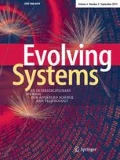Abstract
It is true that the world today suffers greatly from the modernization by humans however the natural disasters in no way do less harm. In the wake of this threat, there is a need of prediction of earthquake magnitude beforehand so as to determine the severity of the disaster and create an early warning system to avoid any casualty as far as possible. To curb the menace of earthquakes, there have been significant improvements in earthquake engineering regarding the study of different seismological parameters that influence earthquakes and generate useful features from them that can be used for earthquake forecasting. In this regard, there are various organizations such as the united states geological survey, the international seismological centre that collect records about details of all the earthquakes, small shockwaves occurring across major continental regions of the world, aid various research works related to earthquake modeling. This article is aimed towards a methodology of combining a neural network model known as functional link artificial neural network with both standard machine learning algorithms and certain nature-inspired optimization algorithms so as to achieve the task of predicting earthquake magnitudes.


Source Chemical Engineering Science, 2016 (http://dx.doi.org/10.1016/j.ces.2016.07.018)






Similar content being viewed by others
References
Adams JW, Sullivan JL (1998) Peak-constrained least-squares optimization. IEEE Trans Signal Process 46(2):306–321
Adeli H, Panakkat A (2009) A probabilistic neural network for earthquake magnitude prediction. Neural Netw 22:1018–1024
Amar E, Khattab T, Zada F (2014) Intelligent earthquake prediction system based on neural network. Int J Civil Environ Eng 8(12):874–878
Angelov Plamen (1994) A generalized approach to fuzzy optimization. Int J Intell Syst 9(3):261–268
Angelov Plamen (2014) Outside the box: an alternative data analytics framework. J Autom Mobile Robot Intell Syst 8(2):29–35
Angelov P, Nikola K (2005) Evolving computational intelligence systems. In: Proceedings of the 1st international workshop on genetic fuzzy systems
Asim KM, Idris A, Iqbal T, Martinez-Alvarez F (2018) Earthquake prediction model using support vector regressor and hybrid neural networks. PLoS ONE, 13(7). https://doi.org/10.1371/journal.pone.0199004
Baruah, RD, Angelov P (2012) Evolving local means method for clustering of streaming data. In: 2012 IEEE international conference on fuzzy systems. IEEE
Baruah RD, Angelov P (2014) DEC: dynamically evolving clustering and its application to structure identification of evolving fuzzy models. IEEE Trans Cybernet 44(9):1619–1631
Bishop CM (1985) Neural networks for pattern recognition. Oxford Press, Oxford
Brahmi M, Chu X (2017) Moth-flame optimization (MFO) algorithm. In: Bozorg-Haddad O (ed) Advanced optimization by nature-inspired algorithms. Springer Publications, Singapore, pp 131–141
Florido E, Aznarte JL, Morales-Esteban A, Martinez-Alvarez F (2016) Earthquake magnitude prediction based on artificial neural networks: a survey. Croat Oper Res Rev 7:159–169. https://doi.org/10.17535/crorr.2016.0011
Geller RJ (1997) Earthquake prediction: a critical review. Geophys J Int 131(3):425–450
Hagan MT, Mehnaj MB (1994) Training feed forward networks with the Marquardt algorithm. IEEE Trans Neural Netw 5(6):989–993
He YL, Zhu QX (2016) A novel robust regression model based on functional link least square(FLLS) and its application to modeling complex chemical processes. Chem Eng Sci J. https://doi.org/10.1016/j.ces.2016.07.018
Ide S, Beroza GC (2011) Does apparent stress vary with earthquake size? Geophys Res Lett 28(17):3349–3352
Jangir N, Pandya MH, Trivedi IN, Bhesdadiya RH, Jangir P, Kumar A (2016) Moth-flame optimization algorithm for solving real challenging constrained engineering optimization problems. In: Proceedings of the students’ international conference on electrical, electronics and computer science (SCEECS 2016). IEEE, Bhopal, IN
Li C, Liu X (2016) An improved PSO-BP neural network and its application to earthquake prediction. Chin Control Decis Conf (CCDC). https://doi.org/10.1109/ccdc.2016.7531576
Majhi SK (2019) How effective is the moth-flame optimization in diabetes data classification. In: Recent developments in machine learning and data analytics. Springer, Singapore, pp 79–87
Majhi SK, Biswal S (2018) Optimal cluster analysis using hybrid K-means and ant lion optimizer. Karbala Int J Mod Sci 4(4):347–360
Majhi SK, Mahapatra P (2019) Classification of phishing websites using moth-flame optimized neural network. In: Emerging technologies in data mining and information security. Springer, Singapore, 2019, pp 39–48
Marquardt DW (1963) An algorithm for least-squares estimation of nonlinear parameters. J Soc Ind Appl Math 11(2):431–441
Mirjalili S (2015) Moth-flame optimization algorithm: a novel nature-inspired heuristic paradigm. Knowl Based Syst 89(1):228–249
Nayak SC, Misra BB, Behera HS (2018) ACFLN: artificial chemical functional link network for prediction of stock market index. Evolving Syst. https://doi.org/10.1007/s12530-018-9221-4
Panakkat A, Adeli H (2007) Neural Network models for earthquake magnitude prediction using multiple seismicity indicators. Int J Neural Syst 17(1):13–33
Rafiei MH, Adeli H (2017) NEEWS: a novel earthquake early warning system using neural dynamic classification and neural dynamic optimization. Soil Dyn Earthq Eng 100:417–427
Reyes J, Morales-Esteban A, Martinez-Alvarez F (2012) Neural networks to predict earthquakes in Chile. Appl Soft Comput J. https://doi.org/10.1016/j.asoc.2012.10.014
Sapna S, Tamilarasi A, Kumar MP (2012) Backpropagation learning algorithm based on Levenberg–Marquardt algorithm. J Comput Sci Inform Technol 2:393–398. https://doi.org/10.5121/csit.2012.2438
Tiampo KF, Shcherbakov R (2012) Seismicity-based earthquake forecasting techniques: ten years of progress. Tectonophysics 522–523:89–121
U.S.A, The U.S. Geological Survey (2017) Significant Earthquakes from 1965 to 2016. https://www.kaggle.com/usgs/earthquake-database
Wang K, Chen Q, Sun S, Wang A (2006) Predicting the 1975 Haicheng Earthquake. Bull Seismol Soc Am 96(3):757–795. https://doi.org/10.1785/0120050191
Wilamowski BM, Yu H (2010) Improved computation for Levenberg–Marquardt training. IEEE Trans Neural Netw 21(6):930–937
Acknowledgements
The authors are very much thankful the anonymous reviewers and editors for their constructive suggestions which significantly facilitate the quality improvement of the article.
Author information
Authors and Affiliations
Corresponding author
Additional information
Publisher's Note
Springer Nature remains neutral with regard to jurisdictional claims in published maps and institutional affiliations.
Rights and permissions
About this article
Cite this article
Majhi, S.K., Hossain, S.S. & Padhi, T. MFOFLANN: moth flame optimized functional link artificial neural network for prediction of earthquake magnitude. Evolving Systems 11, 45–63 (2020). https://doi.org/10.1007/s12530-019-09293-6
Received:
Accepted:
Published:
Issue Date:
DOI: https://doi.org/10.1007/s12530-019-09293-6




